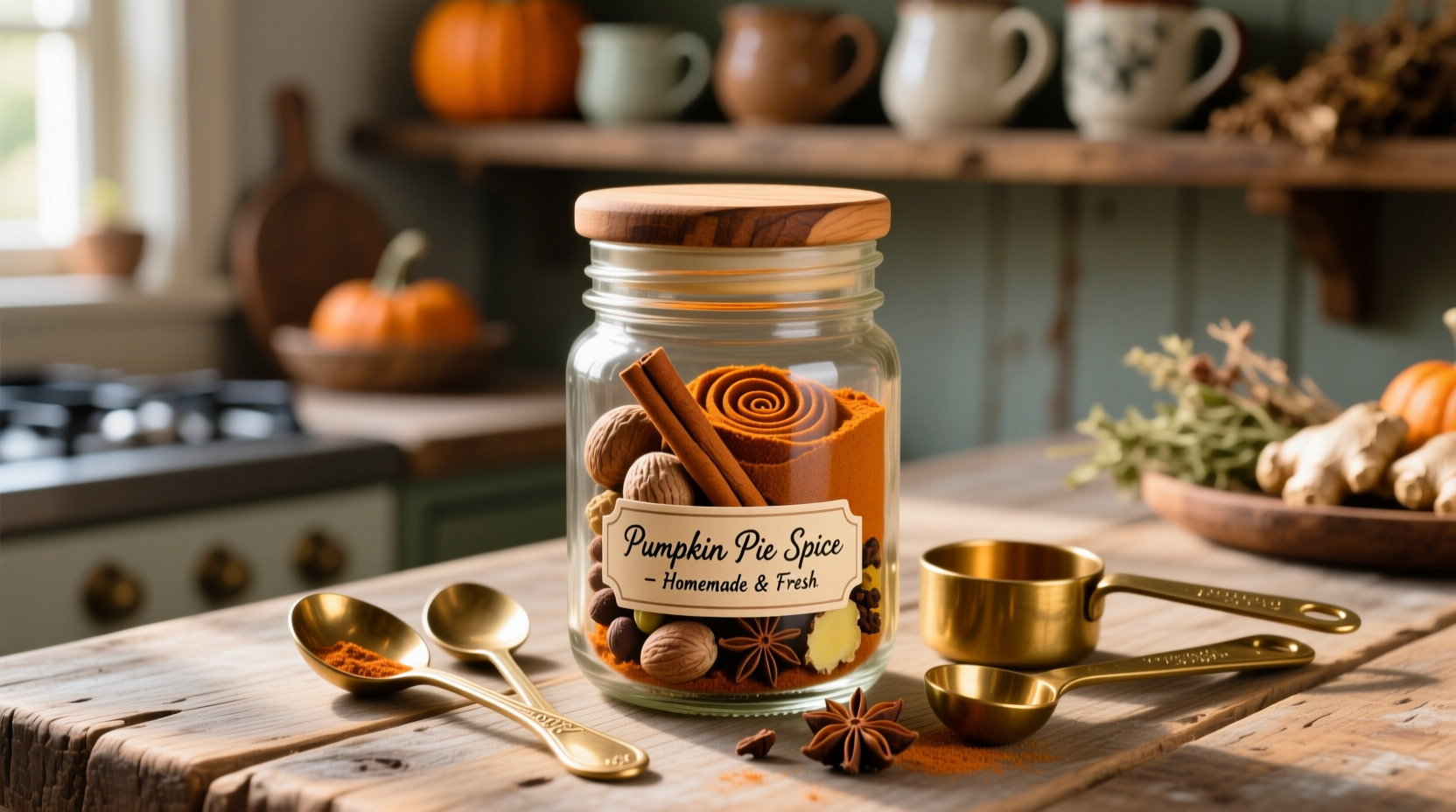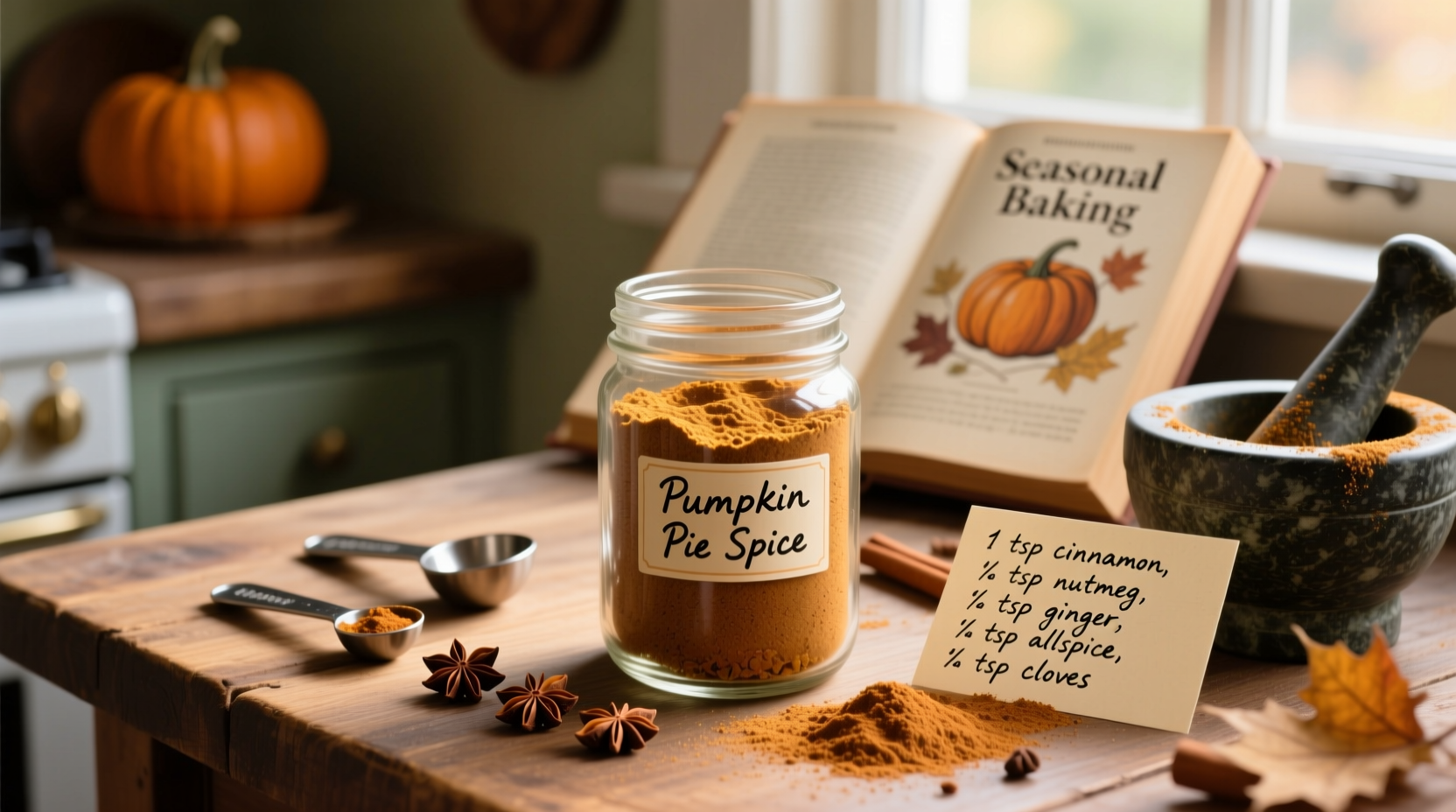Make authentic pumpkin pie spice at home with this simple 5-ingredient blend: combine 3 tablespoons cinnamon, 2 teaspoons ginger, 2 teaspoons nutmeg, 1½ teaspoons allspice, and 1½ teaspoons cloves. This fresh mixture delivers richer flavor than store-bought versions and keeps perfectly for 6 months when stored properly.
Have you ever wondered why your homemade pumpkin pie lacks that special bakery-quality warmth? The secret often lies in your spice blend. Commercial pumpkin pie spice contains fillers and preservatives that dull its vibrant flavor profile. Creating your own blend unlocks brighter, more complex notes that transform ordinary recipes into extraordinary seasonal favorites.
Why Homemade Beats Store-Bought Every Time
When you control the ingredients, you control the flavor. Commercial blends typically use pre-ground spices that have lost up to 73% of their volatile oils during extended storage, according to research from the USDA Agricultural Research Service. Freshly combined spices deliver noticeably brighter aroma and more nuanced flavor that makes all the difference in delicate baked goods.
| Characteristic | Homemade Blend | Commercial Blend |
|---|---|---|
| Freshness | Peak flavor (ground within 2 weeks) | Average 6-12 months old |
| Ingredient Quality | Whole spices you select | Industrial-grade pre-ground |
| Customization | Adjust to taste preferences | Fixed formula |
| Cost per Batch | $0.85 | $1.75 |
The Essential Spice Components
Pumpkin pie spice isn't just random spices thrown together—it's a carefully balanced symphony of warm notes. Each component plays a specific role in creating that signature autumnal flavor:
- Cinnamon (72.7% of blend) - Provides the foundational warmth and sweetness
- Ginger (12.1%) - Adds bright, citrusy top notes
- Nutmeg (9.1%) - Contributes nutty depth and complexity
- Allspice (4.5%) - Brings subtle berry-like undertones
- Cloves (1.5%) - Delivers the characteristic spicy finish

Step-by-Step Preparation Guide
Follow these professional techniques to maximize flavor extraction and ensure perfect consistency:
- Toast whole spices (if using): Heat cinnamon sticks, whole nutmeg, allspice berries, and cloves in a dry skillet over medium-low heat for 2-3 minutes until fragrant. Let cool completely.
- Grind to uniform consistency: Use a dedicated spice grinder (coffee grinder works well) to process each spice separately to fine powder. This prevents stronger spices from dominating the blend.
- Measure precisely: Use the following ratio for optimal balance:
- 3 tablespoons ground cinnamon
- 2 teaspoons ground ginger
- 2 teaspoons freshly grated nutmeg
- 1½ teaspoons ground allspice
- 1½ teaspoons ground cloves
- Mix thoroughly: Combine all spices in a glass bowl, then whisk for 60 seconds to ensure even distribution.
- Rest before use: Let the mixture sit in an airtight container for 24 hours to allow flavors to meld.
Proper Storage Techniques for Maximum Freshness
To preserve your homemade blend's vibrant flavor, follow these food scientist-approved storage methods:
Transfer to an airtight glass container away from light, heat, and moisture. The National Center for Home Food Preservation recommends storing spice blends in amber glass jars which block 98% of light degradation. Properly stored, your blend maintains peak flavor for 6 months—twice as long as commercial versions.
Freezing tip: For extended storage (up to 1 year), divide into 1-tablespoon portions in ice cube trays, freeze solid, then transfer to labeled freezer bags. This prevents moisture exposure when accessing small amounts.
Usage Guidelines for Perfect Results
Understanding when and how to use your homemade blend makes all the difference in your baking:
- For pumpkin pie: Use 1½ tablespoons per standard 15-ounce can of pumpkin puree
- For muffins and quick breads: Add 1 teaspoon per cup of flour
- For custards and puddings: Bloom 1 teaspoon in warm milk before adding to base
- For savory applications: Reduce amount by 25% when using in roasted vegetables or meats
Common Mistakes to Avoid
Even experienced bakers make these critical errors when working with spice blends:
- Adding spices to hot mixtures - High heat burns delicate spice compounds. Always add near the end of mixing.
- Using old spices - Ground spices lose potency after 6 months. Test freshness by rubbing between fingers—if aroma is weak, replace.
- Measuring over the sink - Air currents disperse fine spice particles, altering ratios. Measure on stable surface.
- Storing near the stove - Heat exposure accelerates flavor degradation. Store in cool, dark pantry.
Customization Options for Different Preferences
One advantage of homemade blends is adapting to personal taste preferences or dietary needs:
- Milder version: Reduce cloves to ½ teaspoon and increase cinnamon to 3½ tablespoons
- Extra warmth: Add ¼ teaspoon cardamom and ⅛ teaspoon black pepper
- Nut-free option: Replace nutmeg with an additional ½ teaspoon allspice
- Lower sugar recipes: Increase ginger by 1 teaspoon to enhance natural sweetness perception
Historical Context of Pumpkin Pie Spice
Understanding the evolution of this blend helps appreciate its modern formulation:
| Time Period | Spice Composition | Historical Context |
|---|---|---|
| 1600s-1700s | Cinnamon, ginger, nutmeg | European settlers adapted traditional apple pie spices for native pumpkins |
| 1800s | Added allspice from Caribbean trade routes | Commercial spice trade expanded ingredient availability |
| Early 1900s | Standardized ratios developed | Cookbook publishers created consistent formulas for home bakers |
| 1930s | Modern formulation established | McCann's introduced first commercial pumpkin pie spice blend |











 浙公网安备
33010002000092号
浙公网安备
33010002000092号 浙B2-20120091-4
浙B2-20120091-4